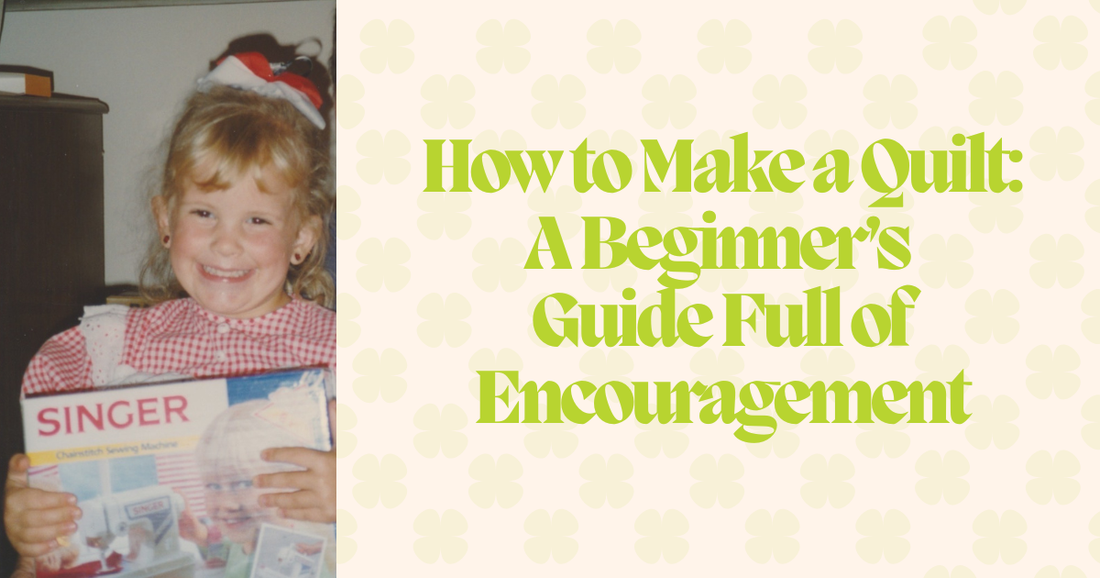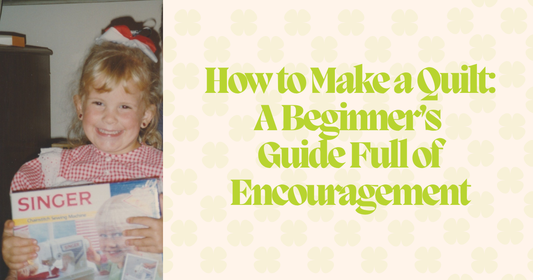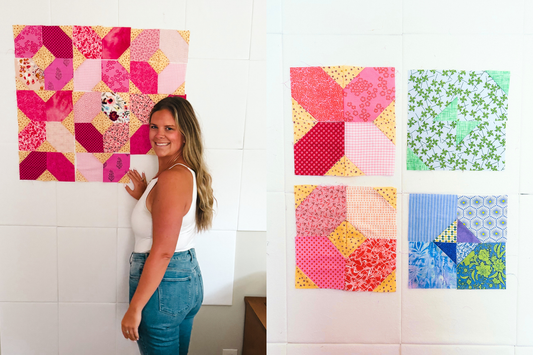
How to Make a Quilt: A Beginner’s Guide Full of Encouragement
Share
Keep scrolling for a summarized checklist of the steps it takes to make a quilt.
Why I Started Quilting
I decided to pick up quilting during the pandemic when my grandmother passed away. She was not just a quilter, but a master of the craft—the president of her quilt guild, the kind of person whose stitches were always perfectly even and whose eye for color was unmatched. She taught me countless tactile skills over the years, like how to hold a needle, how to hem by hand, and how to approach sewing as an act of both creativity and care.
Although she never sat me down and formally taught me quilting, I grew up watching her. For 28 years, I observed her piecing, pressing, and finishing quilts that became treasured family heirlooms. So when she passed, I felt a pull toward quilting—not just as a hobby, but as a way to honor her. Even without direct instruction, I felt confident that I could teach myself. And I did.
I never took a quilting lesson, signed up for a class, or had in-person instruction. Instead, I dove into YouTube tutorials, spent hours FaceTiming my mom as we puzzled through steps together, and occasionally texted my grandma’s best friend for advice. She always had the same response: “There are no quilt police. It looks great!”
That simple phrase stuck with me. Quilting is not about perfection—it’s about joy, patience, creativity, and love. My mom wasn’t formally taught to quilt either, but she, too, had decades of observation. Between the two of us, we pieced together enough knowledge to keep this tradition alive.
Quilting is More Accessible Than You Think
I cannot emphasize this enough: if you have a basic understanding of how to use a sewing machine, you can make a quilt. You don’t need advanced training or years of practice to start. And if you don’t yet know how to thread a machine, wind a bobbin, or sew a straight seam, don’t worry. Those skills are easy to pick up with practice, trial and error, and maybe a few helpful online tutorials.
Quilting may look intimidating because the final results often appear so polished, but every quilter starts in the same place—cutting fabric and sewing one seam at a time. The secret is consistency, not perfection. Even if your seams wobble or your points don’t line up, your quilt will be warm, useful, and beautiful in its own way.
Reasons You Might Start Quilting
Everyone comes to quilting for different reasons, and every reason is a good one. Maybe you:
- Want to make your very first quilt as a personal accomplishment.
- Have a baby in your life (your own or a loved one’s) who you want to wrap in something soft and handmade.
- Are seeking a new hobby that combines creativity with a sense of calm.
- Wish to honor a family member or connect with generations of makers who came before you.
Whatever your motivation, I encourage you to simply begin. Don’t let fear of imperfection hold you back. Your quilt will be as unique as your fingerprint, stitched with your personality and care.
A Beginner-Friendly Pattern Recommendation
If you’re completely new and want the most forgiving pattern, I highly recommend starting with the Layer Cake Squared pattern. This design is approachable for beginners because:
- It uses precut fabric packs (called “layer cakes”), so you don’t have to do much cutting.
- It works equally well with curated bundles or scraps you have left from another project.
- If your seams don’t line up perfectly, the design still looks intentional and beautiful.
In fact, I would argue that quilting “mistakes” are never mistakes at all. They’re signs of the handmade love that went into the piece. Each quilt tells a story, and the quirks in your sewing only make it more special.
Resources to Get Started
If you have zero knowledge of quilting, you’re not alone. I’ve been there, and that’s why I’ve created two resources that will help you feel at home in the quilting world:
- Acronym Blog – An easy guide to all the quilting acronyms (like WOF, HST, and FQ) that can feel overwhelming when you first encounter them.
- Glossary Blog – A beginner-friendly dictionary of quilting terms so you never feel lost when reading a pattern or tutorial.
I’ll continue to post tutorials that break down every step of the quilting process. So if you’re curious, stay tuned—help is on the way.
Making a quilt can be as simple or detailed as you’d like, but most quilts follow the same basic process. Here’s a step-by-step overview:
Encouragement for Beginners
Every step of quilting has a learning curve, but don’t let that discourage you. Remember:
- Your first quilt does not need to be perfect. It just needs to be finished.
- Each quilt is practice. You’ll get sharper with cutting, faster with piecing, and more confident with quilting over time.
- Mistakes are memories. When you look at that slightly crooked seam years from now, you’ll remember the moment you sewed it, the music you were listening to, or the conversation you had with someone you love.
Quilting is about the process, not just the product. It’s about slowing down, creating with your hands, and finding joy in each step.
1. Plan & Choose Materials
- Pick a pattern or design (simple patchwork, half-square triangles, stars, etc.).
- Choose fabric (yardage or precut bundles like fat quarters, charm packs, or jelly rolls).
- Select batting (cotton, polyester, wool, or blends) and a backing fabric.
- Gather basic supplies: rotary cutter, quilting ruler, cutting mat, sewing machine (or hand-sewing tools), pins, and thread.
2. Cut Fabric
- Use your pattern instructions to cut pieces precisely.
- Precuts make this step easier since they’re already trimmed to standard sizes.
3. Piece the Quilt Top
- Sew fabric pieces together into blocks.
- Press seams flat as you go.
- Arrange blocks into rows, then sew rows together to form the quilt top.
4. Assemble the Quilt Sandwich
- Lay out backing (right side down), then batting, then the quilt top (right side up).
- Smooth layers to prevent wrinkles.
- Baste the layers together (with pins, spray adhesive, or hand basting).
5. Quilt the Layers
- Stitch through all three layers to hold them together.
- Options: straight-line quilting, free-motion quilting, or sending to a long-arm quilter.
6. Trim & Bind
- Square up the quilt edges.
- Make or buy binding strips, then attach them around the edges of the quilt.
- Hand-stitch or machine-stitch the binding to finish.
7. Final Touches
- Add a quilt label (date, name, recipient).
- Wash and dry for a soft, crinkly finish (optional).
Quilting has been my bridge to family history, creativity, and self-reliance. I started because I wanted to carry my grandmother’s legacy forward, but I continue because the process itself is meditative and fulfilling. If you’ve ever thought, “I’d like to try that someday,” let me tell you—today is the perfect day to start.
Pick up a sewing machine, choose a pattern, and give yourself permission to make something imperfectly wonderful. Your quilt, no matter what it looks like, will be filled with your time, energy, and care—and that’s what makes it priceless.



